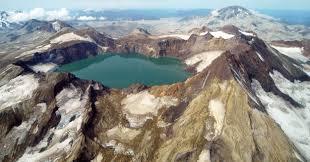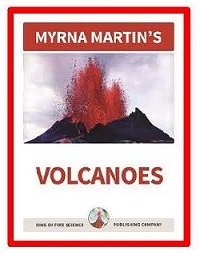Novarupta and Katmai Volcanoes
Source of the eruption
Katmai first thought to be source of the eruption
Katmai volcano was incorrectly thought to be the source of the largest
eruption of the 20th Century. The great eruption began on June 6, 1912
after large earthquakes shook the region on the previous two days. The
area was so remote that it was four years before Robert Griggs led an expedition to investigate the eruption. The expedition was funded by
the National Geographic Society.

Katmai summit with lake in the caldera, USGS
Remote area where eruption occurred
Little was known about Katmai before 1916
Prior to the great eruption the volcano was a little known 7,500 ft
peak in Alaska. The expedition studying the eruption found that the
volcano was drastically altered after the event.
Summit collapsed during eruption
The summit of the
volcano had collapsed when magma drained out of the volcano during the
eruption. The summit's collapse formed a two mile wide caldera that had
started to fill with water from melting snow.
Valley of 10,000 smokes and new lava dome
Valley of 10,000 Smokes
The expedition found a valley with steam rising from thousands of fumaroles. The steam reminded them of Yellowstone Park. They named the area the Valley of 10,000 Smokes.
New dome named Novarupta
The expedition found the valley was filled with pyroclastic material from pyroclastic flows that covered 40 square miles and a small dome a short distance from Katmai volcano.The expedition named the dome Novarupta they thought was a vent of Katmai volcano.


Click for More Information or to Order
Incorrect source of eruption
Katmai identified as the source of the eruption
Griggs was sure that Katmai was the source of the eruption because of the summit collapse on Katmai volcano.
During the next forty years textbooks attributed the great eruption to Katmai.
Katmai National Monument created
Griggs was so impressed with his findings that he persuaded
President Woodrow Wilson to create Katmai National Monument in 1918.
Today the area is a national park where visitors can visit the volcanoes
in the area and watch bears feed on salmon as they come up the streams
in the summer and fall.
real source of 1912 eruption
1950s Novarupta identified as the source of the eruption
Scientists studying the eruption in the 1950s discovered that
Novarupta Volcano was the source of the all the pyroclastic material.
The only new magma that flowed out of Katmai during the eruption formed a
small dome.
Horseshoe Island Dome
The small dome was named Horseshoe Island. Horseshoe Island was
visible when Griggs and his party studied the summit of the Katmai. Today the
island is covered with water. The lake in the caldera is now 800 feet
deep. Small glaciers have also formed on the slopes of the snow covered
peak
KIDS FUN Science Bookstore
Check out Myrna Martin's award winning textbooks, e-books, videos and rock sets. The Kids Fun Science Bookstore covers a wide range of earth science topics. Click here to browse.










